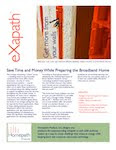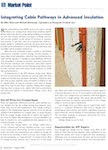Let’s face it, we acquire plenty of stuff. As we amass belongings the value seems obvious. Once gathering dust, its relevance diminishes. It just happens. Making the time to organize, donate, sell, recycle or otherwise dispose of it takes effort...and the activity always seems timed precisely with more pressing issues...like yard work or filling out tax forms. So it grows...leading to “need” for larger spaces. If you really think about the “stuff” we collect, and assess it from a needs versus wants standpoint...much of the “stuff” offers little value. Once we have unnecessary stuff, the dilemma of disposal enters. Clutter. Why start?
Like tropical fish, our footprint grows to the size of the aquarium we swim in...or something like that. I’m not suggesting that we live in confinement but I do recommend that, when planning our spaces, a thorough review of needs is more sensible than defaulting to anticipated overspill.
Thoughtful remodel planning with firms like Myers Constructs in Philadelphia can lead to more efficient use of existing space, improved functionality, and greater long term satisfaction. Spending the time and effort to plan up front helps us get back to important issues like living. You’ve probably heard the maxim “We didn’t have time to do it right the first time, but we found the time to do it again.” Investing in a considerate plan before the first nail is mashed avoids this, improves value, and leads to a more satisfying result. Planning.
Change
There was a time when I burned my calories planning for everything...attempting to think of all potential risks and control the environment in which I lived and worked. This futile effort at girding myself and family against change inevitably became a limitation. The great protector. With time and maturity the notion that change is inevitable was obvious. Have you had these thoughts?
I’m still a planner, but the simple act of embracing change proved eye opening and invigorating. I shed much of the accumulated clutter, materially and emotionally, and began following a path more suited to the needs of my family and me. Change is good, bring it!
Some change is scary...some invigorating
Our society endures tumultuous change on many levels. Daily we’re faced with recessionary pressures, terrorist threat, employment instability, multiple war efforts, healthcare reform and a political system that divides us. (Remember “United we stand, Divided we fall”?) Lots to think and worry about.
Fortunately there are many examples of optimistic change...an area I prefer to spend time and energy on. One that relates directly to my occupation is a shift in how people value living space. As I build rapport with others in the home construction marketplace, it seems there is a desire, if not a trend, to simplify, to rid excess, to eliminate clutter. A shift in value from a life of “things” to a life of “living”. I’m optimistic.
Change can be scary and difficult...anything that stretches you is. Expanding your comfort zone is worthwhile and often leads to improvement, change for the better. Embrace it, build confidence, then add value for those around you. Are these changes where your next great opportunity rests?
Spaces
I’m inspired by the work of accomplished architects and designers. They constantly challenge themselves to consider the function and artistry of spaces. Beyond aesthetics, they reconcile the impact their work has on its surroundings and this extends to the broader environment. Social responsibility in design. A good direction, positive change, but daunting to resolve.
I often cite and recommend to homeowners Sarah Susanka, prescient architect and author, noted for her work and insights on quality over quantity.
From The Not So Big House, A Blueprint for the Way We Really Live I borrow the passage. “Given how rapidly technological change is occurring, it is crucial that we figure out a way to accommodate change without having to tear out and throw away substantial portions of the house in the process....The house of the future will be designed so that unpredictable, changing technology can be integrated into the building without sacrificing aesthetics....We can be certain that conservation and maintainability are issues that will continue to have value.”
Like a kid in a candy shop
Home design is transforming. Here are just a few examples where major strides have occurred:
- High function, multipurpose spaces
- Living areas sized to satisfy needs while minimizing energy waste associated with unusable space
- Geothermal climate control systems borrowing energy from within the earth itself to augment heating and cooling, reducing carbon footprint and lowering operational costs
- Improved sprayfoam insulation that optimizes R-value and mitigates energy sapping convection
- Home automation technology constantly monitoring climate and lighting within the home, learning and optimizing to the needs of the occupants
- Media rooms and entertainment systems intelligently serving up “atmosphere” for listening enjoyment or full theater-like experience
- Web accessibility through wired and wireless systems
The list goes on.
The point is to acknowledge that new materials, equipment, systems and knowledge provide fertile ground for improved design on an infrastructure level. Assembling them in functional, aesthetic and budget conscious plans require the experience that talented design professionals offer. Value worth paying for.
Ideas + action = enhanced value
Ideas. With every wave in progressive home construction, opportunity for innovation swells.
The problem
Despite impressive energy savings with better insulation, a new and pressing problem is inadvertently created. To efficiently insulate a home, insulation fills all voids within the wall cavities. Open and closed-cell sprayfoam insulation is well suited to the task of flowing into and expanding within hard-to-reach spaces.This leaves little or no possibility for air transfer, which, for minimizing convection, is a very good thing. However, these advanced foams also flow around installed wires and open-backed low voltage media outlets. When it comes time to install or maintain wired subsystems, this is a major headache.
- Do you believe that consumer electronics are done changing?
- Is it reasonable to expect low voltage wiring changes in the future?
- Does it make sense to embed today’s wiring technology in the walls, limiting your ability to move, add or upgrade cables in the future?
That’s the way it’s done
“The way we’ve always done it.” At best, when using traditional approaches to handling wires in walls, you’re left with cables permanently stapled to the studs within your walls and having to “fish” new wires in as modern consumer electronics come to market.
Reframe the problem, think differently, develop value. Electronic gadgetry is here to stay. Staggering advances occur every year. Can you envision life without a TV, a computer, a DVR or an iPod? Probably not...but just ten years ago the answer would likely have been a resounding yes....well within the life expectancy of any new home.
Change....why fight it when you can master it?
For readers who are unfamiliar with Homepath Products and our innovative system called eXapath™ here is a brief summary. We’re very new and we solve an emerging problem.











.jpg)


No comments:
Post a Comment